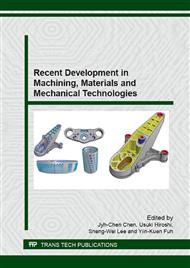p.308
p.314
p.320
p.328
p.335
p.341
p.347
p.353
p.357
Machining Feasibility of a New Developed Medium in Electrical Discharge Machining
Abstract:
The environment issue and green machining technique have been induced intensive attention in recent years. It is urgently need to develop a new kind dielectric to meet the requirements for industrial applications. The aim of this study is to develop a novel dielectric using gas media immersed in deionized water for electrical discharge machining (EDM). The developed machining medium for EDM can fulfill the environmentally friendly issue and satisfy the demand of high machining performance. The experiments were conducted by this developed medium to investigate the effects of machining parameters on machining characteristics in terms of material removal rate (MRR) and surface roughness. The developed EDM medium revealed the potential to obtain a stabilizing progress with excellent machining performance and environmentally friendly feature.
Info:
Periodical:
Pages:
335-340
Citation:
Online since:
July 2015
Authors:
Price:
Сopyright:
© 2015 Trans Tech Publications Ltd. All Rights Reserved
Share:
Citation:


